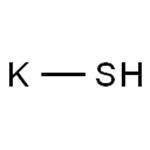Chemical Properties
White to yellow crystals; hydrogen sul-
fide odor. Forms the polysulfide when exposed to
air. Hygroscopic; soluble in alco-
hol and water.
Uses
Separation of heavy metals.
General Description
POTASSIUM HYDROSULFIDE contains potassium hydrosulfide in solution. POTASSIUM HYDROSULFIDE will have a rotten egg like odor. POTASSIUM HYDROSULFIDE has a pH between 8.5-11.5. POTASSIUM HYDROSULFIDE is a transparent to dark green liquid. Contact with heat or acidic materials will evolve highly toxic hydrogen sulfide. The liquid is highly corrosive to the skin and eyes. Ingestion causes severe burning and corrosion in all portions of the gastrointestinal tract.
Air & Water Reactions
Addition of water to hydrosulfide may drop the pH and allow copious quantities of hydrogen sulfide to be produced. Acid accelerates the H2S production.
Reactivity Profile
Inorganic sulfides are generally basic and therefore incompatible with acids. Many of these compounds are reducing agents and therefore react vigorously with oxidizing agents, including inorganic oxoacids, organic peroxides and epoxides. Simple salts of sulfides (such as sodium, potassium, and ammonium sulfide) react vigorously with acids to release hydrogen sulfide gas
Health Hazard
TOXIC; inhalation, ingestion or skin contact with material may cause severe injury or death. Contact with molten substance may cause severe burns to skin and eyes. Avoid any skin contact. Effects of contact or inhalation may be delayed. Fire may produce irritating, corrosive and/or toxic gases. Runoff from fire control or dilution water may be corrosive and/or toxic and cause pollution.
Fire Hazard
Non-combustible, substance itself does not burn but may decompose upon heating to produce corrosive and/or toxic fumes. Some are oxidizers and may ignite combustibles (wood, paper, oil, clothing, etc.). Contact with metals may evolve flammable hydrogen gas. Containers may explode when heated.




